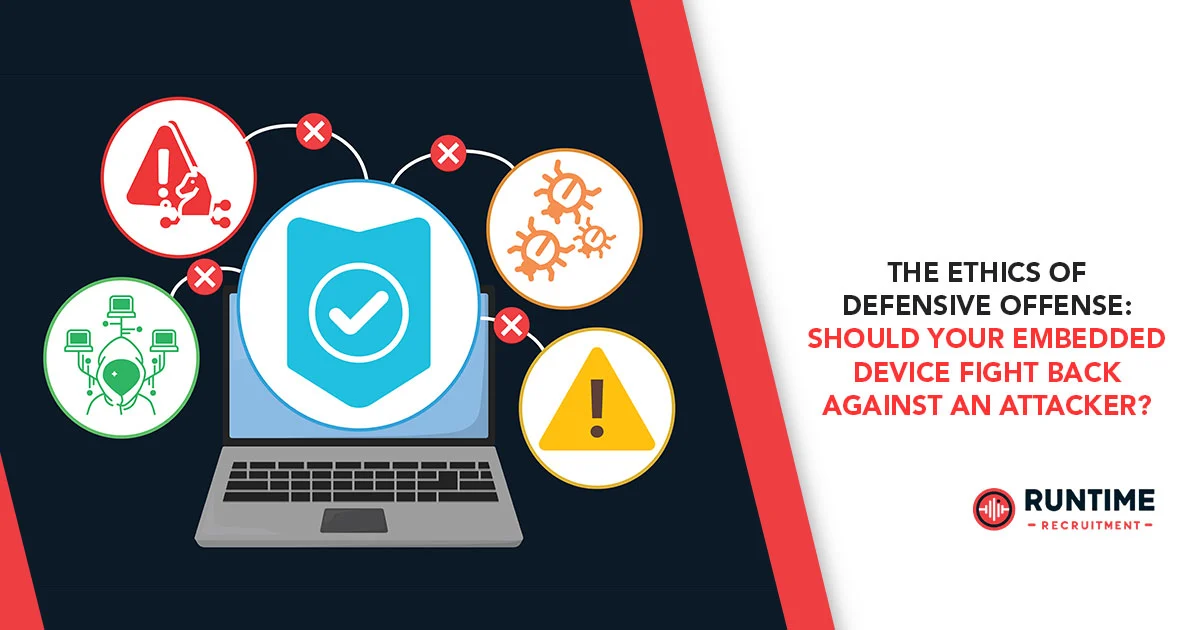The era of embedded systems—the silent, tireless workhorses in our smart homes, medical devices, and industrial control systems—is defined by connectivity. Yet, this omnipresent connectivity is a double-edged sword. While it enables incredible utility, it exposes these resource-constrained devices to an ever-evolving and often hostile cyber threat landscape. For years, the security philosophy for embedded devices has been purely defensive: patch vulnerabilities, encrypt data, and isolate systems. But as attacks become more sophisticated, coordinated, and physically damaging, a new, controversial concept is gaining traction: active defense, or the “defensive offense.”
This paradigm shift asks a profound question of embedded engineers: Should your device fight back against an attacker?
This is not a simple technical challenge; it’s a minefield of ethical, legal, and practical complexities. Implementing a countermeasure that goes beyond mere self-protection and actively engages—or even attempts to harm—an attacker is a radical step. It moves the embedded device from being a passive victim to an active combatant, crossing a critical line from defense to a form of cyber-retaliation.
Defining the Line: Passive Defense vs. Active Defense
To navigate this ethical debate, we must first clearly define the terms, particularly in the context of resource-constrained embedded systems (ES).
Passive Defense: The Traditional Stance
Passive defense focuses entirely on protecting the device and its data without interacting offensively with the threat actor. This is the bedrock of modern embedded security.
- Encryption and Authentication: Using protocols like TLS/SSL and strong cryptographic hardware to ensure confidentiality and integrity of data, and confirming the identity of users and other devices.
- Secure Boot and Firmware Updates: Employing a hardware root of trust to ensure that only cryptographically signed and verified firmware can execute, preventing tampering at the boot level.
- Hardware Security Modules (HSMs) and Secure Elements (SEs): Dedicated physical components for securely storing keys and executing cryptographic operations, protecting them from software-level attacks or physical probing.
- Intrusion Detection Systems (IDS): Monitoring system logs, network traffic, and behavior for anomalies and flagging an attack, but taking only internal mitigation steps (e.g., logging off a user, shutting down a non-critical port).
These mechanisms focus on maximizing resilience and minimizing the attack surface. They are ethically sound because their actions are contained entirely within the device’s authorized boundary.
Active Defense: The Leap Across the Chasm
Active defense involves employing offensive tactics to disrupt, mislead, or even punish an attacker. While often used interchangeably, it is critical to separate the ethically and legally defensible tactics from the highly problematic ones.
Ethical and Practical Active Defense (Deception and Deterrence)
These techniques are largely contained within the defender’s own network space and are aimed at gathering intelligence or wasting the attacker’s time and resources.
- Honeypots and Decoys (Deception Technology):
- The Technique: Creating fake endpoints, services, or data stores that appear to be legitimate, but are in fact traps. An attacker who engages with a honeypot reveals their tactics, tools, and intentions without ever reaching the actual target.
- In ES Context: An IoT gateway could advertise a fake, unsecure port or a decoy API endpoint. An attacker trying to connect would be shunted into a monitored sandbox environment.
- Ethical Stance: Generally considered ethical. The device is not leaving its authorized boundaries; it is simply presenting a fabricated reality within its own domain. It’s akin to having a fake safe that contains no valuables but alerts the police when tampered with.
- Throttling and Rate Limiting (Deterrence):
- The Technique: Upon detecting suspicious activity (e.g., thousands of failed login attempts, an aggressive port scan), the device drastically slows down or temporarily blocks the source IP address.
- In ES Context: A smart thermostat detecting a high-rate query attack could increase the time-delay for responding to the attacking IP from milliseconds to multiple seconds, effectively crippling the attack’s efficiency.
- Ethical Stance: Uncontroversial. This is a proportional response that maintains the device’s availability for legitimate users while making the attack resource-intensive for the attacker.
The Defensive Offense (The Retaliation Debate)
This category represents the controversial end of the spectrum, actions that cross the boundary of the protected system and attempt to directly impact the attacker’s systems or identity. These are often referred to as “hack-back” or “cyber counterstrikes.”
- Retaliatory Scanning/Probing: A device, upon being attacked, initiates a scan of the attacker’s system to gather intelligence (e.g., OS, running services, geographic location).
- Counter-Attack Payloads: The device actively sends malicious data or a command back to the attacker’s machine, aiming to disable their system, delete their data, or corrupt their tools.
- Automated Information Warfare: The device or its controlling platform attempts to publicly expose the attacker’s identity or attack infrastructure.
It is these last three points that move the conversation from security engineering to ethical and legal philosophy.
The Legal and Ethical Labyrinth of “Fighting Back”
For an embedded engineer, the decision to implement a true “fight back” mechanism is not a technical specification—it’s a moral and legal exposure that could have far-reaching professional and corporate consequences.
Legal Jurisprudence: The “Hack-Back” Problem
In nearly all jurisdictions, retaliatory measures like “hacking back” are illegal for private entities.
1. Unauthorized Access and Computer Crime Laws
The core legal issue is that a retaliatory strike—even a proportional one—constitutes unauthorized access to a third-party computer system. In the United States, the Computer Fraud and Abuse Act (CFAA) criminalizes this, meaning a device performing a hack-back is itself committing a federal crime. Other countries have similar laws. A device designed to fight back is, by its nature, designed to violate the law.
2. Jurisdiction and Attribution
Cyberattacks are non-physical, crossing international borders instantly. If a device in an American factory retaliates against a server located in Eastern Europe, what country’s laws apply? This is the issue of sovereignty. Furthermore, attribution in cyberspace is notoriously difficult. An attacker can easily launch their attack through a compromised third-party system—a ‘zombie’ device belonging to an innocent person or company.
The Collateral Damage Nightmare: A defensive offense targeting an IP address might not hit the original attacker, but an unsuspecting hospital server or a private citizen’s router. The device manufacturer, and by extension, the designing engineer, could be held criminally and civilly liable for the damage caused to the innocent third party. This risk of collateral damage is the single greatest practical argument against automated, offensive retaliation.
3. Proportionality and Escalation
Legal defense often hinges on proportionality (did the response match the threat?). How does an embedded system, with limited computational power and contextual awareness, accurately judge the severity of an attack to ensure its retaliation is proportional? If a device responds to a harmless vulnerability scan with a data-wiping payload, the legal defense for the manufacturer is non-existent.
Furthermore, a counterstrike can easily lead to escalation. A minor attack could be met with a major retaliation, prompting the original attacker (or the party whose system was mistakenly targeted) to launch a devastating second-wave attack. This turns a localized security incident into a full-blown, potentially destructive cyber conflict.
Ethical Frameworks: Utilitarianism vs. Deontology
Embedded engineers operate under a professional ethical code, often guided by broader philosophical principles.
A. Utilitarian Ethics (The Consequentialist View)
This framework judges an action based on its outcome—the greatest good for the greatest number.
- Argument FOR Retaliation: If a swift counterstrike can successfully dismantle a botnet’s command-and-control server, preventing it from attacking millions of other embedded devices, the net benefit (saving millions of devices from harm) outweighs the harm to the single attacker (their server being disrupted). The act of hack-back is morally justified because the consequence is overwhelmingly positive.
- Argument AGAINST Retaliation: The uncertainty of attribution means the retaliation could cause harm to an innocent party (collateral damage), resulting in a net negative outcome. Because this risk is so high in cyberspace, the utilitarian calculation often fails to justify the offensive action.
B. Deontological Ethics (The Duty-Based View)
This framework judges an action based on the morality of the action itself, regardless of the outcome. It focuses on duties, rules, and fundamental principles (like “do no harm”).
- Argument AGAINST Retaliation: The duty of a computer system is to operate within the established boundaries of the law and not to violate the property or privacy of others. Since an offensive counterstrike involves unauthorized access and risks collateral damage, the act itself violates a fundamental ethical duty, regardless of whether it saves the device. The means—committing a cybercrime—are inherently unethical.
- The Engineer’s Duty: An engineer’s primary professional duty is to the safety, health, and welfare of the public. Designing a system that could potentially harm an innocent third party’s infrastructure by operating illegally would be a breach of this professional duty.
In the context of embedded systems, which are often safety-critical (automotive, medical), the Deontological argument for restraint is far stronger. The ethical mandate is clear: prioritize safety and reliability over vigilante justice.
The Embedded Engineering Imperative: A New Defensible Roadmap
The conclusion from an ethical and legal standpoint is that true cyber-retaliation (hack-back) is an unjustifiable risk for private manufacturers of embedded systems. The engineering focus must, therefore, be on maximizing the ethically sound forms of active defense: Deception and Deterrence.
Here is the professional imperative for embedded engineers:
1. Prioritize Resilience Over Retaliation
The first and most enduring line of defense is a well-engineered, robust system.
- Hardware Root of Trust: Design the silicon to be inherently secure, making it impossible to boot or execute unsigned code.
- Minimal Attack Surface: Utilize lightweight, secure operating systems (like an RTOS) and employ the principle of least privilege in the device’s software architecture.
- Fail-Safe Design: Ensure that any detected attack triggers a system state that is safe (e.g., shutting down a critical function to prevent manipulation) rather than an aggressive, outward-facing countermeasure.
2. Implement Intelligence-Driven Deception
This is the sweet spot for ethical active defense: the use of honeypots and honeytokens that confuse the attacker and generate valuable threat intelligence.
- Decoy Services: Deploy virtual, low-interaction services on the network that mimic real device services but are fully instrumented for monitoring. If an attacker connects to this decoy, the real devices are instantly alerted, and the attack is contained and documented.
- Fake Credentials/Tokens: Embed fake, high-value, but non-functional API keys or user credentials (“honeytokens”) within the device’s memory or configuration files. If these tokens are used externally, it is irrefutable proof of a successful breach and exfiltration, providing an instant, high-fidelity alarm.
3. Perfect Proportional Deterrence
Focus defensive-offense capabilities on actions that solely affect the attacker’s ability to use your device or your network for harm.
- Zero-Trust Micro-Segmentation: Isolate devices on the network such that an attacker gaining control of one device cannot move laterally to others. The best counter-attack is a pre-emptive segmentation that limits the blast radius to a single, contained victim.
- Adaptive Rate Limiting & Blocking: Sophisticated algorithms can detect malicious packet patterns and automatically block that specific connection or IP address for a limited time. This is a proportional self-defense mechanism designed to preserve the device’s availability, not to destroy the attacker’s system.
The Future is in the Design
The temptation of the “defensive offense” is understandable. It’s a desire to restore fairness to a lopsided fight where defenders must be right 100% of the time, and attackers only once. However, the path of hack-back is riddled with unacceptable legal and ethical liabilities. For the embedded engineer, the future of security lies not in becoming a vigilante, but in mastering cyber resilience through intelligent, pre-emptive, and bounded systems.
The most ethical and effective defense is one that makes the cost of attack so prohibitively high—through deception, rapid isolation, and rock-solid architecture—that the attacker gives up long before they succeed. The device’s primary fight must always be for its own integrity, not for a retaliatory strike against a phantom enemy. The embedded system must be a shield, not a sword.
Your Next Move
The discussion around embedded system security is evolving faster than ever. Are you ready to design the next generation of resilient, secure, and ethically sound connected devices?
RunTime Recruitment specializes in connecting visionary embedded engineers with companies leading the charge in critical infrastructure, IoT, and medical technology. If you are passionate about the intersection of firmware, hardware, and cybersecurity ethics, it’s time to connect with a team that understands the depth of your work.
Contact RunTime Recruitment today to explore opportunities in cutting-edge embedded security design.









